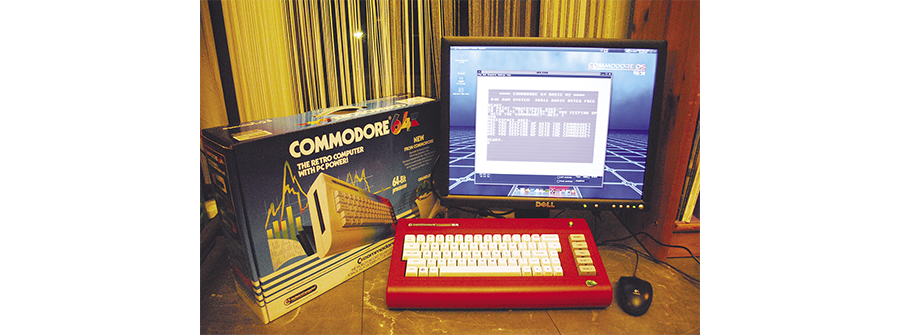Keeping Up with the Commodore
The Commodore home computer is back with new hardware and software options, including a new Commodore 64 machine from the classic brand.
There have been many attempts to bring back the Commodore C64 or some machine that looks like it: You can get replacement mainboards that work in the original case, you can buy a THEC64 or its mini version from Retro Games Ltd, and there’s also the MEGA65 project, which created a modern FPGA-based version of the Commodore C65 – a successor to the C64 that never reached the manufacturing stage. All those machines have one thing in common: Their main goal is to let you run original C64 programs, either with an emulator or with an FPGA-based re-implementation of the original hardware. The latest development is that Christian Simpson (known as PeriFractic on YouTube) has bought the Commodore brand and is partnering up with other groups to bring new and official Commodore products to market.
For those of you who only care about the look and the unique breadbox form factor of the C64, the Commodore 64x (with an extra “x”) is a modern computer in a C64-like case with a keyboard that resembles the C64 keyboard while offering a layout that works with PC operating systems. That machine was originally available from 2011 to 2012, it came with its own Commodore-branded Linux, and it was revived in a Kickstarter campaign in 2022. My Retro Computer Ltd. is still offering a number of C64x configurations, including a bare-bones (case only, no mainboard) version. The website links to mini-itx.com where prices range from £210 (~$279) for the empty case to £990 (~$1,1315) for the C64x Infinity with an AMD Ryzen 9 7940HS, 64GB RAM, and a 500GB M.2 SSD. A configurator lets you change the details.
In addition to the hardware, the 2011/2012 Linux distribution has also been updated: Commodore OS Vision 3.0 is a lovingly customized version of MX Linux 23 (which itself is based on Debian GNU/Linux 12). While it is intended for use with the C64x machines, there’s no stopping you from running it on any modern computer (or in a virtual machine). I’ll look at the software first, because that’s what everyone will have access to. Then in the second part of the article I’ll talk about the C64x case and its keyboard.
Commodore OS Vision
The 35GB ISO image (CommodoreOS3-20250422_0209.iso) boots into a live system that lets you try out all parts of the distribution. Turn on your speakers before the desktop appears, because you’ll be treated to some computer voice output. When the desktop appears, Commodore OS first displays a welcome screen and then asks you to agree to terms and conditions. Don’t just close that window: If you do, you’ll get a notification that the system cannot be used without agreeing and “will now self destruct,” and it reboots after closing that note.
If you get past the terms and conditions, the MX Linux installer (Figure 1) starts and checks the integrity of the DVD. Close it if you simply want to play around with the Live system. Otherwise, the installer lets you pick the right keyboard settings and partition your hard disk, and then it copies the files to the disk. While that’s happening, you can set computer and domain names, change the workgroup for the Samba (SMB) server (or disable it), and select locales and the time zone (with both defaulting to Australia) – that’s it. While the regular MX installer will also let you configure a user account and set a root password, Commodore OS skips that step. Instead it automatically creates a default user called Commodore with the password C=, and you can later auto-login to the installed system and become root via sudo su without entering a password. Once the installation is done, you can reboot. When you start Commodore OS Vision from the hard disk for the first time, it opens a series of information dialogs. Close one window and the next one appears.
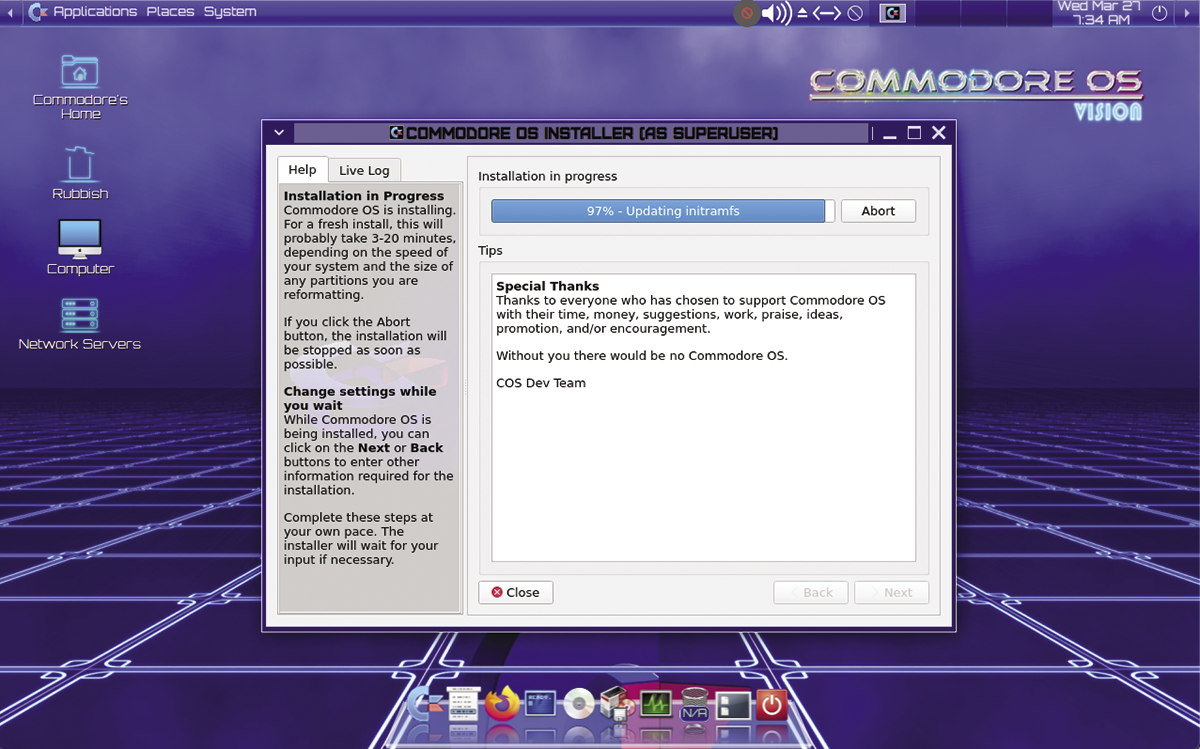
The pre-installed software is a mix of fairly new and older software. You get Kernel 6.12.7 (from December 2024), an older Mate 1.26 desktop (2021) with wobbly window movement and a cube animation for desktop switching, LibreOffice 7.4.7 (from 2023), and some of the other applications that are part of Debian 12 (Bookworm). An update via
apt update; apt upgradedownloaded and installed 1.44GB of software. While the project website states that Commodore OS Vision 3.0 was released on April 22, 2025, the software identifies as “v3.0 (Beta 8).”
Emulators
The Linux distribution features a selection of home computer emulators. There are two sub-menus named Commodore Emulators and Emulators in the Applications menu. The Commodore section contains entries for the 8-bit machines (which all launch VICE 3.7.1) and the Amiga computers (using FS-UAE 3.1.66), but they all lack the required ROMs. For the C64, the emulator includes open source ROM replacements, so it will launch, but it cannot handle any of the included C64 games. In order to get the emulators to run properly, you need to obtain official ROMs from Cloanto or extract them from an original machine’s ROM chips.
Via the System | Commodore OS | Commodore OS Settings menu, you can download the “Free Express Version” from the C64 Forever website. While the script claims you have to manually download a file, you can just close the browser window, and the script fetches and unpacks the .msi file (Figure 2). Once that process has completed, you can run the C64 emulator with its proper ROMs. Note that it is pre-configured to simulate two joysticks when pressing any of the WASD (joystick #2) or cursor keys (joystick #1). If you need to enter text, press Alt+O (or select Preferences | Settings from the menu) to open the settings, navigate to Input devices | Joystick and disable the option Allow keyset joysticks (Figure 3). Also, if you want to use a USB joystick (e.g., the classic Competition Pro, which is period-correct for a C64), you need to open the drop-down list below Joystick #2 and select the joystick (which will be the last entry in the list). If you later notice that a game expects a joystick in the first joystick port, open the dialog again and click on Swap joysticks. That will swap the settings for Joystick #1 and Joystick #2.
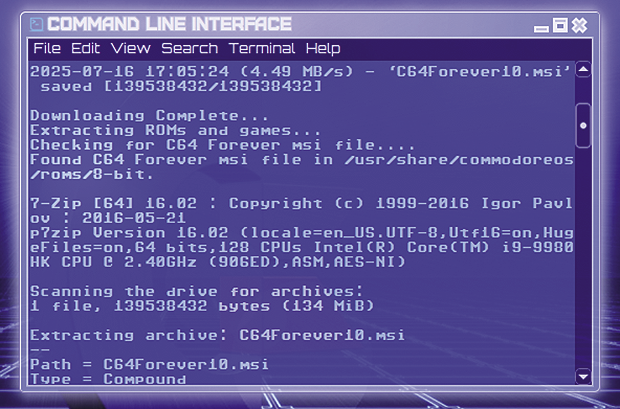
C64Forever.msi from Cloanto’s server.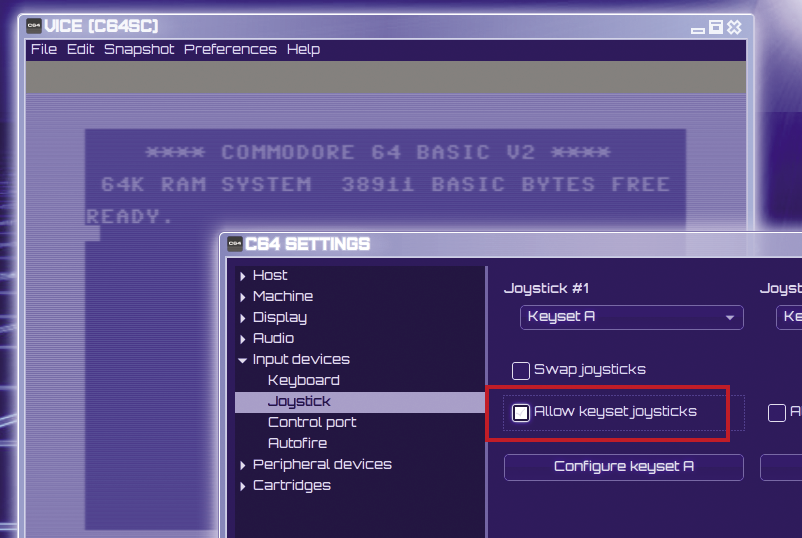
Inside the C64 emulator, press Alt+W to enter Warp mode. The system will run much faster, which is especially useful when you’re loading a game from a virtual cassette tape or floppy. Press the same hotkey again to switch back to regular mode when the game is done loading – otherwise it might be unplayable. The distribution has a lot of games, demos, and audio files pre-installed: You can find them in the file manager by following the Classic Software link in your home directory. There are 88 C64 games in the Commodore/C64/Games/Original_Commodore_Games subfolder. Double-clicking one of the pre-installed files in the file manager should automatically load them in the Vice emulator. If that does not work, right-click the file and select Open With LOAD in the context menu.
After you’ve run the Cloanto installer, you get 100 additional games, stored in Commodore/C64/Games/Cloanto_C64_ Forever_Games. A double click on one of those .rp9 files will open an archive that contains a .d64 file that you can run in VICE.
If you’re not happy with the selection of C64 games, you can visit the Internet Archive’s C64 Software Library; they’ve got everything. When I played around with this system, I had to try out Arkanoid, one of the classics (Figure 4).
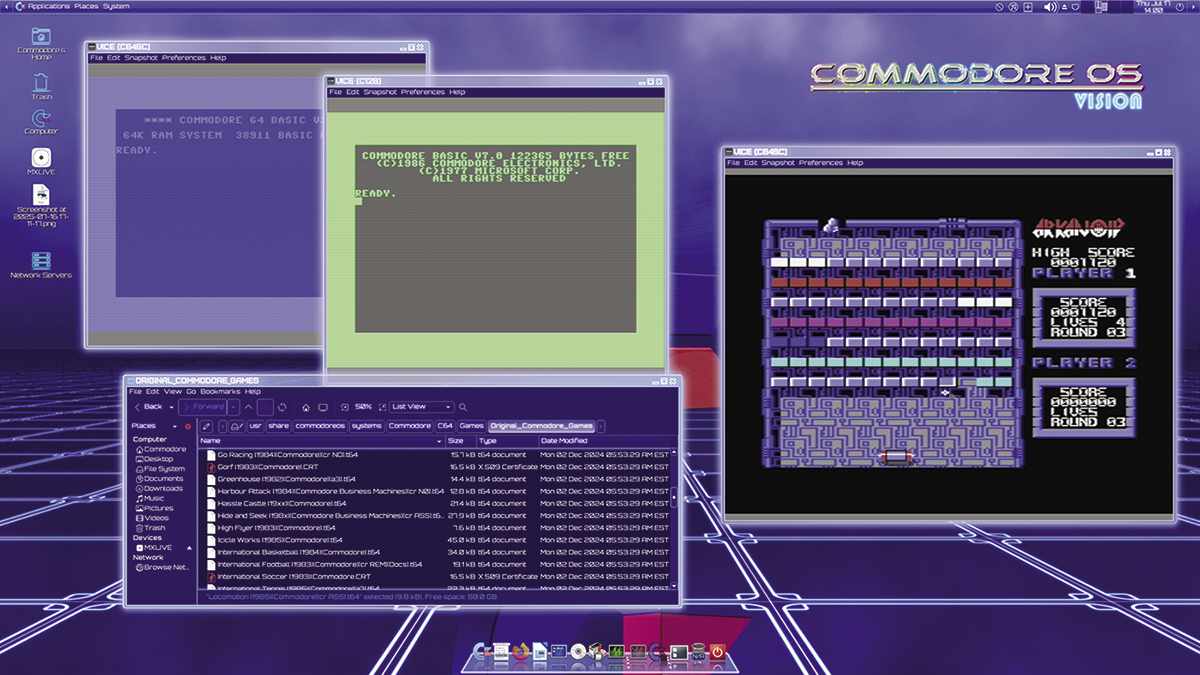
The Amiga emulator (FS-UAE) requires ROMs, too. The Cloanto Commodore ROM setup tool will also help you with those, but they are not available for free. You can buy the Amiga Forever 11 Value Edition for EUR20 (~$23) from Cloanto’s Amiga Forever store. In the Emulators sub-menu, you find various non-Commodore emulators, for example DOSBox, Playstation 1/2/3, Sega Genesis/Saturn, ZX Spectrum, and MEGA65 (xemu), but many of them will not start without adding ROMs or other media.
In addition to the emulators, you can also play modern games: Under Applications | Game Services and Tools you will find menu entries for Steam, GOG, Lutris, the Heroic Games Launcher, Wine, and PlayOnLinux, and the Applications | Games menu offers more than 200 games, sorted by category: Those were not available in Commodore OS 2, and that explains why the ISO image is 35GB instead of the predecessor’s 6GB.
Desktop
If you want to use Commodore OS Vision for regular tasks as well, you will eventually work with the shell. The terminal program has been configured to use a C64-like font, and the shell prompt ends in READY. on a separate line, mimicking the C64 BASIC prompt. It also features a blinking cursor. Run a terminal and the C64 emulator side-by-side, adjust the font size in the terminal, and you will see that they are lookalikes.
The desktop theme with its various shades of blue is pretty unique, too, and the system is noisy, both audibly and visually: Many actions, such as closing or resizing a window, are accompanied by system sounds, and the wobbling windows and animated dock icons create a restless atmosphere. Of course, you can change all those settings and get rid of elements you don’t like: This is a Linux distribution, after all.
The Commodore 64x
The intended use of Commodore OS Vision is to install it on a modern Commodore-lookalike. I contributed to the 2022 Kickstarter campaign by My Retro Computer, and, as is custom with retro-computing projects, it was more than a year and a half until a pretty red Commodore 64x case was delivered to my door. The bare-bones case does not contain a mainboard or a power adapter, so I bought an Asus Prime J4005I-C Mini-ITX board with a built-in Intel Celeron SoC, a Pico PSU (internal power supply), a universal (external) power supply, a small SSD drive, and an 8GB DDR4 memory stick. All of that fits nicely inside the case (Figure 5); there was only a minor problem with connecting the internal and external power supplies. I removed the USB hub on the right side of the case and put the Pico PSU’s power plug in its place. The suggested solution is to drill a hole into the case, but I did not want to risk ruining it. I had opted for a hard-drive dock add-on, which lets you insert and remove an SSD or hard disk without opening the case. However, that requires screwing a lever to the drive, and the eject procedure is difficult and might break the dock if done too often. There are better solutions for hot-swapping disks.
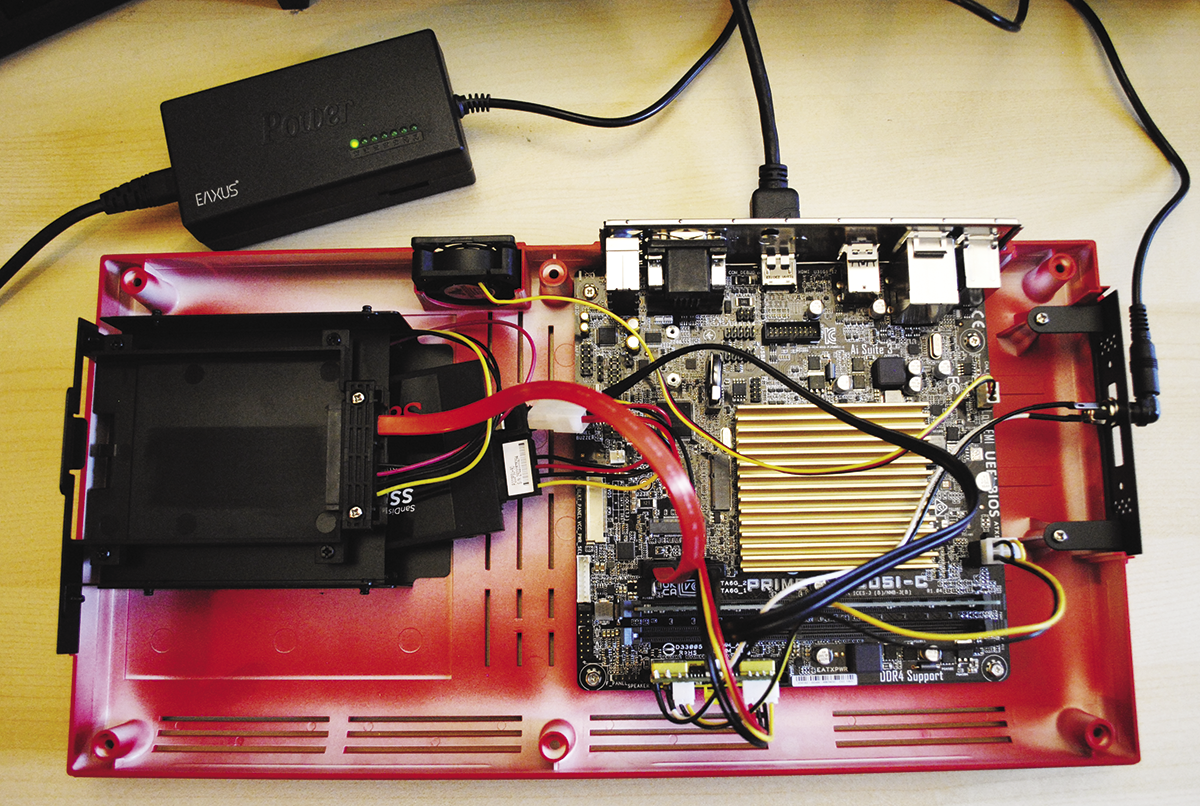
Whereas Retro Games’ THEC64 uses the authentic keyboard layout of the original machines, the Commodore 64x comes with a somewhat similar but modernized layout (Figure 6). It lets you use the internal computer with a modern operating system, such as Windows or Linux. The keyboard has no function keys, but you can hold the Fn key and press 1 to 0, - and = to generate F1 to F12 keystrokes. However, hotkeys such as Alt+F4 require some skillful finger placement, and you need both hands.
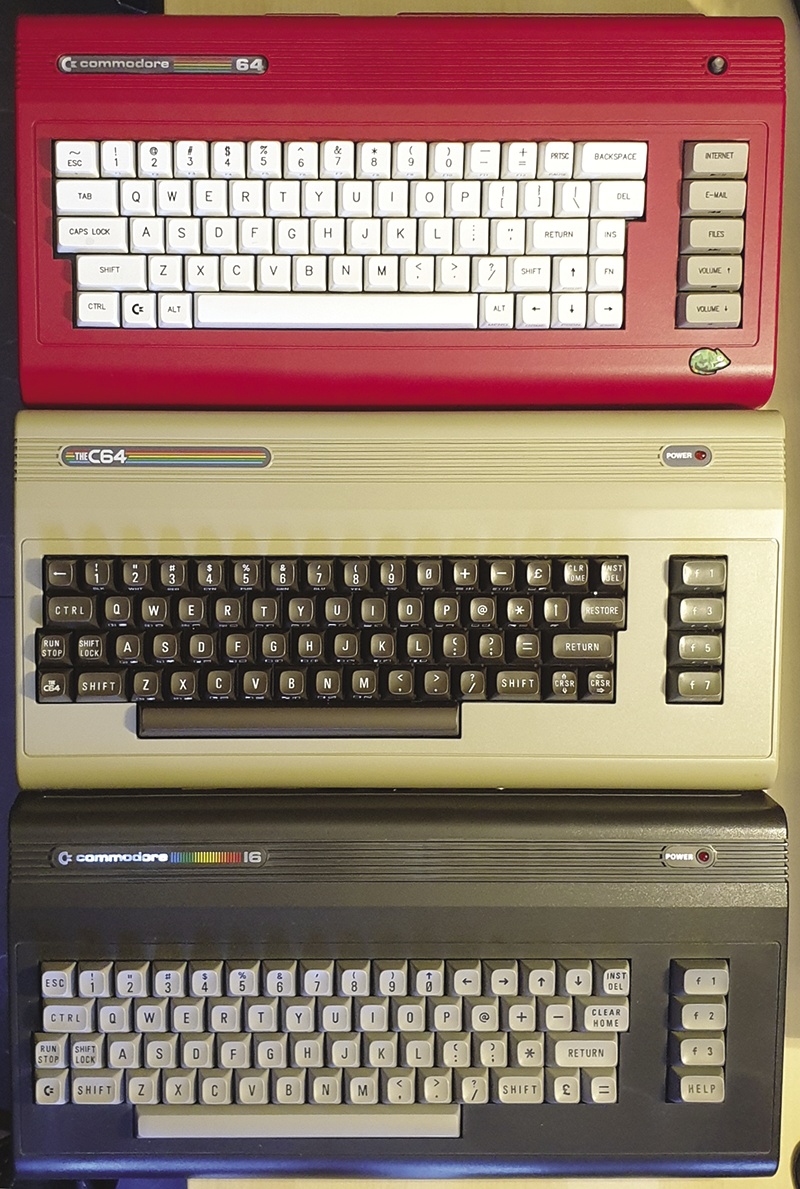
It makes no sense that the keyboard has no function keys, because there are five wide special keys on the right (where a classic C64 has its four function keys). These keys would have been good candidates for function keys, but on the C64x they are labeled Internet, E-Mail, Files, and Volume up/down. When used with Fn they turn into media control keys.
Bringing Back Commodore
In July 2025, Christian “PeriFractic” Simpson announced that he bought the Dutch company that owned the Commodore brand name and some of the related intellectual property. He’s gathered a team of Commodore enthusiasts (including some of Commodore’s former staff from the old days) and is currently marketing the FPGA-based Commodore 64 Ultimate on the new Commodore website.
Final Thoughts
While I’ve been critical of some of the design choices in both the Commodore OS Vision Linux distribution and the Commodore 64x case and keyboard, it is important to remember that these are both projects created by Commodore fans for Commodore fans. You cannot at the same time cram a full standard keyboard into such a case and preserve the look of the original machine. It also makes sense that a dedicated Commodore-styled Linux distribution differs a lot from our standard systems because what would be the point if it didn’t?
Mixing current technology and the classic case lets you build a pretty gaming rig that plays both the classic games of the old home computers and – depending on what kind of hardware you put inside – current games. I would not recommend the machine for daily work if it involves typing a lot: The keyboard layout is just too different, and while you could connect a regular keyboard, that would look a little silly. But for gaming, web browsing, watching videos, or consuming other media, it is a good alternative to a boring standard computer box, and it will be an eye-catcher in the living room if you place it next to your TV. For maximum nostalgia, connect an older monitor with a 4:3 aspect ratio (ideally a CRT) and run the C64 emulator in full screen.
The 1980s brand still exists in 2025 because several projects have been keeping it alive. As they used to say in the TV ads: “Are you keeping up with the Commodore? ’Cause the Commodore is keeping up with you!”. With the latest news about the Commodore acquisition hopes are up that this remains true today.

